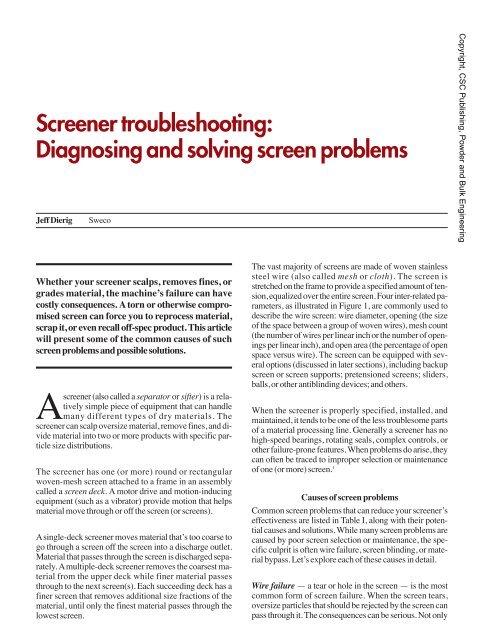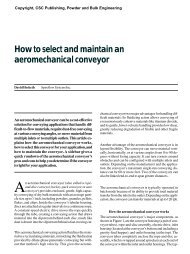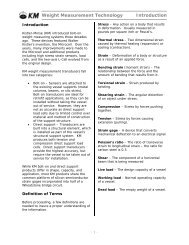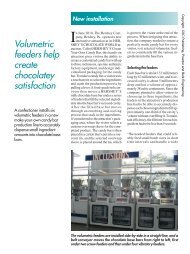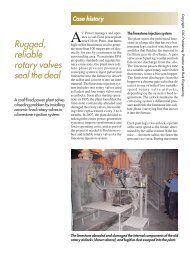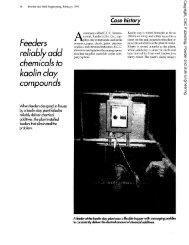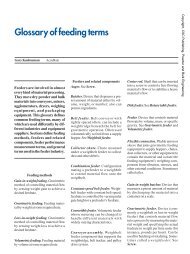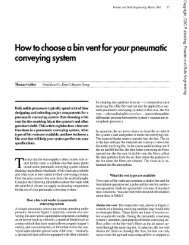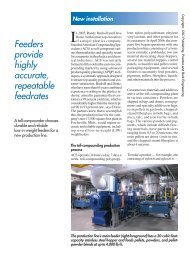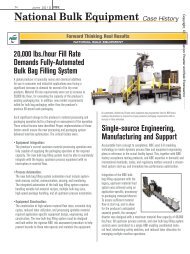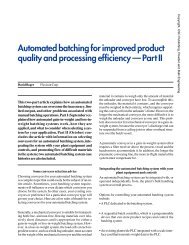Screener troubleshooting: Diagnosing and solving screen problems
Screener troubleshooting: Diagnosing and solving screen problems
Screener troubleshooting: Diagnosing and solving screen problems
You also want an ePaper? Increase the reach of your titles
YUMPU automatically turns print PDFs into web optimized ePapers that Google loves.
<strong>Screener</strong> <strong>troubleshooting</strong>:<br />
<strong>Diagnosing</strong> <strong>and</strong> <strong>solving</strong> <strong>screen</strong> <strong>problems</strong><br />
Jeff Dierig<br />
Sweco<br />
Copyright, CSC Publishing, Powder <strong>and</strong> Bulk Engineering<br />
Whether your <strong>screen</strong>er scalps, removes fines, or<br />
grades material, the machine’s failure can have<br />
costly consequences. A torn or otherwise compromised<br />
<strong>screen</strong> can force you to reprocess material,<br />
scrap it, or even recall off-spec product. This article<br />
will present some of the common causes of such<br />
<strong>screen</strong> <strong>problems</strong> <strong>and</strong> possible solutions.<br />
A<strong>screen</strong>er (also called a separator or sifter) is a relatively<br />
simple piece of equipment that can h<strong>and</strong>le<br />
many different types of dry materials. The<br />
<strong>screen</strong>er can scalp oversize material, remove fines, <strong>and</strong> divide<br />
material into two or more products with specific particle<br />
size distributions.<br />
The <strong>screen</strong>er has one (or more) round or rectangular<br />
woven-mesh <strong>screen</strong> attached to a frame in an assembly<br />
called a <strong>screen</strong> deck. A motor drive <strong>and</strong> motion-inducing<br />
equipment (such as a vibrator) provide motion that helps<br />
material move through or off the <strong>screen</strong> (or <strong>screen</strong>s).<br />
A single-deck <strong>screen</strong>er moves material that’s too coarse to<br />
go through a <strong>screen</strong> off the <strong>screen</strong> into a discharge outlet.<br />
Material that passes through the <strong>screen</strong> is discharged separately.<br />
A multiple-deck <strong>screen</strong>er removes the coarsest material<br />
from the upper deck while finer material passes<br />
through to the next <strong>screen</strong>(s). Each succeeding deck has a<br />
finer <strong>screen</strong> that removes additional size fractions of the<br />
material, until only the finest material passes through the<br />
lowest <strong>screen</strong>.<br />
The vast majority of <strong>screen</strong>s are made of woven stainless<br />
steel wire (also called mesh or cloth). The <strong>screen</strong> is<br />
stretched on the frame to provide a specified amount of tension,<br />
equalized over the entire <strong>screen</strong>. Four inter-related parameters,<br />
as illustrated in Figure 1, are commonly used to<br />
describe the wire <strong>screen</strong>: wire diameter, opening (the size<br />
of the space between a group of woven wires), mesh count<br />
(the number of wires per linear inch or the number of openings<br />
per linear inch), <strong>and</strong> open area (the percentage of open<br />
space versus wire). The <strong>screen</strong> can be equipped with several<br />
options (discussed in later sections), including backup<br />
<strong>screen</strong> or <strong>screen</strong> supports; pretensioned <strong>screen</strong>s; sliders,<br />
balls, or other antiblinding devices; <strong>and</strong> others.<br />
When the <strong>screen</strong>er is properly specified, installed, <strong>and</strong><br />
maintained, it tends to be one of the less troublesome parts<br />
of a material processing line. Generally a <strong>screen</strong>er has no<br />
high-speed bearings, rotating seals, complex controls, or<br />
other failure-prone features. When <strong>problems</strong> do arise, they<br />
can often be traced to improper selection or maintenance<br />
of one (or more) <strong>screen</strong>. 1<br />
Causes of <strong>screen</strong> <strong>problems</strong><br />
Common <strong>screen</strong> <strong>problems</strong> that can reduce your <strong>screen</strong>er’s<br />
effectiveness are listed in Table I, along with their potential<br />
causes <strong>and</strong> solutions. While many <strong>screen</strong> <strong>problems</strong> are<br />
caused by poor <strong>screen</strong> selection or maintenance, the specific<br />
culprit is often wire failure, <strong>screen</strong> blinding, or material<br />
bypass. Let’s explore each of these causes in detail.<br />
Wire failure — a tear or hole in the <strong>screen</strong> — is the most<br />
common form of <strong>screen</strong> failure. When the <strong>screen</strong> tears,<br />
oversize particles that should be rejected by the <strong>screen</strong> can<br />
pass through it. The consequences can be serious. Not only
does the end product fail to meet specifications, but it can<br />
be dangerous: In many applications a <strong>screen</strong> is used to remove<br />
objectionable or even hazardous oversize particles.<br />
Once the <strong>screen</strong> tears, there’s no longer any assurance that<br />
such particles will be rejected.<br />
Backup <strong>screen</strong> <strong>and</strong> <strong>screen</strong> supports support the fine<br />
<strong>screen</strong>, minimizing the stress caused by the heavy or<br />
abrasive material while allowing the fines to pass<br />
through.<br />
Wire failure is most commonly caused by wire fatigue:<br />
During <strong>screen</strong>ing, the wire is constantly vibrated. Just as a<br />
paper clip eventually breaks when you bend it back <strong>and</strong><br />
forth several times, the <strong>screen</strong> wire eventually weakens<br />
<strong>and</strong> breaks from the wire’s vibration-induced up-<strong>and</strong>down<br />
movement. Another common cause of wire fatigue<br />
is abrasion, which occurs particularly when you’re <strong>screen</strong>ing<br />
heavy or abrasive materials such as s<strong>and</strong> <strong>and</strong> other<br />
minerals. The particles’ constant movement across the<br />
<strong>screen</strong> abrades the wire, reducing its diameter <strong>and</strong> making<br />
it weaker.<br />
When designing a processing line that includes a <strong>screen</strong>er,<br />
you must consider the possibility of wire failure. Your material’s<br />
particle size, weight, <strong>and</strong> other characteristics, the<br />
quantity of material that must be <strong>screen</strong>ed over a given<br />
time, <strong>and</strong> other factors all affect how your <strong>screen</strong>s will<br />
st<strong>and</strong> up. You can select a <strong>screen</strong> (including such factors as<br />
its mesh material, wire diameter, opening, mesh count,<br />
<strong>and</strong> open area), mesh tension, <strong>and</strong> <strong>screen</strong> attachment<br />
method that are suitable for your application.<br />
You can also select options to further ensure your <strong>screen</strong>’s<br />
long life. For example, if you’re using a very fine <strong>screen</strong><br />
with heavy or abrasive material, the <strong>screen</strong> won’t last long.<br />
But by using backup <strong>screen</strong> (also called backup mesh) or<br />
<strong>screen</strong> supports, you can extend the <strong>screen</strong>’s life. Backup<br />
<strong>screen</strong> is a coarse <strong>screen</strong> that’s mounted directly under the<br />
fine <strong>screen</strong> on the same <strong>screen</strong> deck. Screen supports are<br />
metal bars, usually configured in an open grid pattern, attached<br />
to the <strong>screen</strong> deck <strong>and</strong> mounted under the fine<br />
<strong>screen</strong>. Backup <strong>screen</strong> <strong>and</strong> <strong>screen</strong> supports support the<br />
fine <strong>screen</strong>, minimizing the stress caused by the heavy or<br />
abrasive material while allowing the fines to pass through.<br />
One caution: These options can slightly reduce the<br />
<strong>screen</strong>er’s capacity or make it harder for antiblinding devices<br />
to do their job.<br />
Wire fatigue isn’t the only cause of <strong>screen</strong> tears or holes.<br />
Foreign or tramp material — such as metal shavings or<br />
bolts from upstream equipment — can break right through<br />
the <strong>screen</strong>. Good maintenance practices (discussed in the<br />
later section “Screen maintenance”) can help prevent this<br />
cause of <strong>screen</strong> failure.<br />
Copyright, CSC Publishing, Powder <strong>and</strong> Bulk Engineering<br />
Figure 1<br />
Four inter-related parameters for woven wire <strong>screen</strong><br />
0.100 inch<br />
Opening<br />
size<br />
Mesh count = 40<br />
Wire diameter = 0.0065 inch<br />
Opening size = 0.0185 inch<br />
Open-area percentage = 54.8 percent<br />
Opening size =<br />
—————<br />
1<br />
wire diameter<br />
mesh count<br />
Open-area percentage =<br />
(opening size mesh count) 2 100<br />
Wire<br />
diameter
Table l<br />
Troubleshooting <strong>screen</strong>ing <strong>problems</strong><br />
Problem Cause Solution<br />
Off-spec end product: Screen opening too Select a <strong>screen</strong> with<br />
too many oversize large a smaller opening.<br />
particles<br />
Hole or tear in <strong>screen</strong><br />
Replace <strong>screen</strong>.<br />
Material bypass<br />
Check seals <strong>and</strong> gaskets.<br />
Use a pretensioned <strong>screen</strong>.<br />
Off-spec end product: Screen opening too Select a <strong>screen</strong> with<br />
too many fines small a larger opening.<br />
Severely blinded<br />
See “Screen blinding”<br />
<strong>screen</strong><br />
problem below.<br />
Screen overloaded<br />
Reduce feedrate.<br />
Low product yield from a Upper <strong>screen</strong> blinded See “Screen blinding”<br />
multiple-deck <strong>screen</strong>er<br />
problem below.<br />
Upper <strong>screen</strong> opening<br />
Select an upper <strong>screen</strong><br />
too small<br />
with a larger opening.<br />
Lower <strong>screen</strong> failed<br />
Check lower <strong>screen</strong> for<br />
holes or tears.<br />
Lower <strong>screen</strong> opening<br />
Select a lower <strong>screen</strong> with<br />
too large<br />
a smaller opening.<br />
Copyright, CSC Publishing, Powder <strong>and</strong> Bulk Engineering<br />
Screen blinding Wire diameter too heavy Select a <strong>screen</strong> with a<br />
lighter wire diameter.<br />
Worn sliders or balls<br />
Check antiblinding devices<br />
<strong>and</strong> replace them as<br />
needed.<br />
Screen blocked with<br />
Clean or replace <strong>screen</strong>.<br />
material<br />
Screen overloaded<br />
Reduce feedrate.<br />
Short <strong>screen</strong> life Wire diameter too light Select a <strong>screen</strong> with<br />
a heavier wire diameter.<br />
Use a backup <strong>screen</strong>. Add<br />
<strong>screen</strong> supports.<br />
Improper h<strong>and</strong>ling<br />
Be careful not to crease<br />
or dent <strong>screen</strong>s during<br />
h<strong>and</strong>ling or installation.<br />
Screen overloaded<br />
Reduce feedrate.<br />
Screen corroded<br />
Instead of stainless<br />
steel wire mesh, try<br />
alternative alloys or use<br />
a <strong>screen</strong> made of a<br />
synthetic material.<br />
Screen blinding occurs when some or all of the <strong>screen</strong>’s<br />
open area is blocked by material. This may be caused by a<br />
too-high feedrate that dumps material onto the <strong>screen</strong><br />
faster than the <strong>screen</strong> can operate. Or it might be caused by<br />
poor <strong>screen</strong> selection — for example, choosing a <strong>screen</strong><br />
with too heavy a wire diameter. Or it might be caused by<br />
your material’s characteristics, such as cohesiveness.<br />
Blinding is often behind a gradual degradation in your<br />
<strong>screen</strong>er’s performance — such as a drop in production<br />
quantity or product quality.<br />
Screen blinding causes fines that should pass through the<br />
<strong>screen</strong> to discharge with the oversize particles. As a result,<br />
the end product doesn’t meet specifications. For example,<br />
if blinding occurs in a fines removal application, where the<br />
end product is the material that normally passes over the<br />
<strong>screen</strong> while objectionable fines pass through it, product<br />
quality can be compromised. The product’s fines content<br />
eventually will increase to the point that the particle size<br />
distribution falls outside acceptable limits.<br />
If a <strong>screen</strong> begins to blind <strong>and</strong> is left untreated, the <strong>screen</strong><br />
will eventually become totally blinded over. At this point<br />
it’s no longer a <strong>screen</strong>; it’s simply a conveyor.<br />
Often blinding can be controlled by selecting the right<br />
equipment <strong>and</strong> options such as antiblinding devices. Common<br />
antiblinding devices are sliders (plastic rings) <strong>and</strong> balls<br />
that are installed on a coarse <strong>screen</strong>, perforated plate, or<br />
other support underneath the <strong>screen</strong>. The <strong>screen</strong>er’s vibration<br />
causes the sliders or balls to contact the <strong>screen</strong> bottom,<br />
dislodging any material that might be stuck in the openings.
Antiblinding devices, like the sliders shown here,<br />
help prevent particles from sticking in the <strong>screen</strong><br />
openings.<br />
Over time, many antiblinding devices wear <strong>and</strong> lose their<br />
effectiveness. Proper monitoring <strong>and</strong> maintenance of the<br />
devices will keep your <strong>screen</strong>s clear <strong>and</strong> free from blinding.<br />
Material bypass is another common cause of <strong>screen</strong> <strong>problems</strong>.<br />
Material bypass happens when something causes<br />
the <strong>screen</strong> mesh to separate from its frame, allowing material<br />
to pass between the mesh <strong>and</strong> the frame, or — less<br />
often — when the gasket or seal between the <strong>screen</strong> deck<br />
<strong>and</strong> the <strong>screen</strong>er housing fails, allowing material to pass<br />
between the <strong>screen</strong> deck <strong>and</strong> the housing. The latter problem<br />
doesn’t occur often; the seal or gasket between the<br />
<strong>screen</strong> deck <strong>and</strong> <strong>screen</strong>er housing is usually reliable. But<br />
certain methods of attaching the mesh to its frame are<br />
more likely to allow material bypass.<br />
Commonly, <strong>screen</strong> mesh is attached to the <strong>screen</strong> frame by<br />
clips or bolts. These are placed at regular intervals around<br />
the <strong>screen</strong> frame, <strong>and</strong> an operator in your plant or the<br />
<strong>screen</strong> manufacturer’s plant manually attaches the mesh to<br />
each clip or bolt. In the spaces between the clips or bolts,<br />
the mesh isn’t attached to the frame, but the <strong>screen</strong> tension<br />
effectively seals the mesh to the frame. If the <strong>screen</strong> is mish<strong>and</strong>led,<br />
the mesh isn’t attached to the frame properly or<br />
maintained properly, or a clip or bolt fails, the mesh can<br />
come away from the frame, leaving a hole that material<br />
can pass through.<br />
<strong>screen</strong> maintenance starts with regular inspections. Depending<br />
on your application, these might be done every<br />
hour, every shift, every week, or at another regular interval.<br />
Look for tears, signs of blinding, <strong>and</strong> gaps between the<br />
<strong>screen</strong> mesh <strong>and</strong> frame.<br />
In addition to finding immediate <strong>problems</strong>, regular inspections<br />
can give you the information you need to take preemptive<br />
action to prevent <strong>screen</strong> failure during processing,<br />
which will require you to shut down your process while<br />
you change <strong>screen</strong>s. For example, if your inspections<br />
show that a <strong>screen</strong> typically lasts 9 weeks, you can change<br />
the <strong>screen</strong> after 7 or 8 weeks during scheduled downtime<br />
<strong>and</strong> avoid the interruption to your process. Or, if your material<br />
has corroded the <strong>screen</strong>, you can replace it with a<br />
<strong>screen</strong> made of mesh of a different steel alloy or a synthetic<br />
material.<br />
After inspecting the <strong>screen</strong>, clean it off if needed. The<br />
cleaning method will depend on your material <strong>and</strong> process<br />
<strong>and</strong> can range from light brushing of dry, lightweight particles<br />
to power-washing of heavy or cohesive particles from<br />
the <strong>screen</strong>.<br />
PBE<br />
Reference<br />
1. For detailed information on how to properly select a <strong>screen</strong>, see<br />
“Choosing a woven wire <strong>screen</strong> for top separation performance,”<br />
Powder <strong>and</strong> Bulk Engineering, December 2006, page 17.<br />
For further reading<br />
Find more information on <strong>screen</strong>s <strong>and</strong> <strong>screen</strong>ers in articles<br />
listed under “Screening <strong>and</strong> classifying” in Powder <strong>and</strong><br />
Bulk Engineering’s comprehensive “Article index” at<br />
www.powderbulk.com <strong>and</strong> in this issue.<br />
Copyright, CSC Publishing, Powder <strong>and</strong> Bulk Engineering<br />
If you want to be sure material bypass can’t occur, you can<br />
purchase pretensioned <strong>screen</strong>s.These <strong>screen</strong>s are assembled<br />
at the manufacturer’s plant <strong>and</strong> the mesh is epoxied to the<br />
<strong>screen</strong> frame’s entire circumference, making it impossible<br />
for the mesh to come away from the frame <strong>and</strong> form a gap.<br />
Screen maintenance<br />
While it’s true that practically all <strong>screen</strong>s will fail if left to<br />
operate indefinitely, any <strong>screen</strong>’s service life can be maximized<br />
through proper selection <strong>and</strong> maintenance. Proper<br />
Jeff Dierig is global marketing manager at Sweco, 8029<br />
US Highway 25, Florence, KY 41042; 800-807-9326 or<br />
859-727-5116, fax 859-727-5122 (jeff.dierig@sweco.com,<br />
www.sweco.com). He holds a BA in marketing <strong>and</strong> an<br />
MBA, both from Northern Kentucky University in Highl<strong>and</strong><br />
Heights, <strong>and</strong> has more than 14 years experience with<br />
bulk solids processing equipment.


